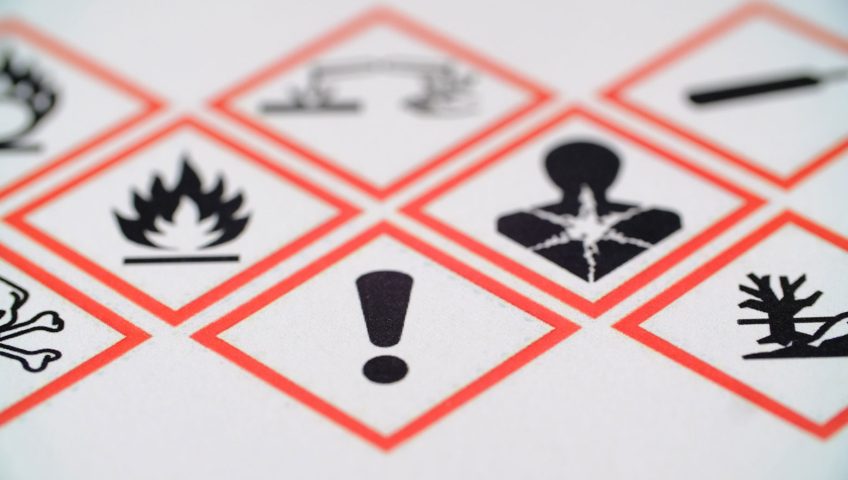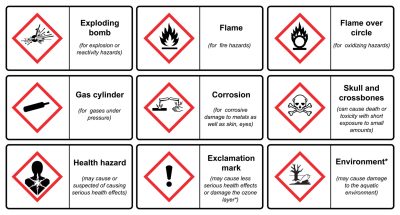
The Most Important Information on GHS Labels: What You Need to Be Compliant
The GHS label is a critical component of hazardous material handling safety. This standardized label system is used around the world and provides easy-to-access information about the hazard class of chemicals and the best ways to deal with them. Learning about the globally harmonized system of classification and labeling of chemicals can help you simplify the labels of your chemical products and keep you compliant with occupational safety standards.
What Are GHS Labels, and How Are They Used?
Globally Harmonized System (GHS) labels are used internationally to identify hazardous chemicals and their dangers. Despite being developed by the World Health Organization and United Nations and used internationally, standards for these safety labels vary slightly from country to country. This allows label elements to be understood no matter where they end up while allowing adjustments for local safety regulations. After slowly phasing in this standard, GHS was fully implemented by OSHA’s HAZCOM regulations in 2016.
GHS labels are intended for use during transport and storage of chemical containers but aren’t required for retail sale. For example, a bottle of cleaner will have applicable safety warnings and instructions for the end user, while the case those containers are shipped in will have a GHS label. Large containers that are shipped without a secondary container, like barrels and industrial pails, need a GHS label to meet shipping and storage requirements.
Most of the information on GHS labels is also included on Material Safety Data Sheets (MSDS). The GHS label makes hazard information accessible to anyone near the container.
GHS label requirements include:
-
- GHS Pictograms
- Product identifiers
- Signal Words
- Hazard Statements
- Precautionary Statements
- Supplier Identification
Hazard Pictograms and Signal Words
Pictograms are the most important part of the GHS label. They quickly identify the hazards associated with the product and are universally understood. The required pictograms vary depending on where the label is used.
The signal word is either “Danger!” or “Warning!” This word goes directly above the pictograms and must match the word used on the MSDS. “Danger!” is more hazardous than “Warning!” The signal word is determined by the most dangerous ingredient in the product.
Pictograms establish major chemical hazards at a glance. Along with standard GHS pictograms, there are separate pictograms used for transport. In some cases, you may need to add an NFPA hazard diamond.

There are eight standard pictograms used on OSHA-compliant labels. These include health hazards, flammable chemicals, irritants, pressurized gasses, corrosives, explosives, oxidizers, and poisons. There’s also a pictogram for environmental hazards. This last graphic is optional on OSHA-compliant labels but may be required on labels for products shipped to other countries. If you want to know more about these pictograms, we go into more depth in our blog “Labeling System Options for Chemicals.”
Shipping labels are covered by Federal regulation 49 CFR 172. Labels that meet this standard need to use GHS transport pictograms.
Specific hazard classifications have pictograms assigned to them:
Division 1: Explosion hazards
Division 2: Gasses that are explosive, toxic, asphyxiants, or oxidizers
Division 3: Flammable liquids
Division 4: Flammable and combustible solids
Division 5: Other hazards, including corrosives, oxidizers, and organic peroxides
If the label is on a container used for storage and transport, it needs both standard and transport pictograms.
For an explosion hazard, an exploding bomb hazard symbol is used on the chemical container. For toxic or infectious hazard materials, a skull and crossbones are used. To indicate a flammable hazardous material, a flame will be placed on the GHS label. Radioactive material features a trefoil symbol followed by the word “Radioactive” and red bars to indicate the level of radioactivity. GHS chemical labels for chemicals that can cause skin corrosion will feature an image of liquid pouring from two glass vessels – one onto metal and the other onto a hand.
Local safety regulations may need to meet the National Fire Prevention Association’s 704 hazard identification standard. This standard uses a diamond-shaped graphic to denote safety hazards. It’s divided into four color-coded sections:
Red – Flammability
Blue – Health
Yellow – Instability
White – Special
Red, yellow, and blue hazards are ranked by number from “0” for minimal hazard to “4” for extreme hazard. The white section uses symbols for oxidizers, asphyxiant chemicals, and chemicals that react with water. It’s common practice to include the NFPA 704 diamond alongside GHS pictograms.
Product Identifiers
To have a GHS-compliant label, the common product identifier must be the same as the name on the MSDS for the product. If the name contains multiple ingredients, they must be listed in order with their percentages. Hazardous material labels used for transport must include a CAS registry number. This number identifies the exact chemical substance in the container, making it easier to identify.
Hazard Statements and Precautionary Statements
Hazard communication standards are standardized phrases assigned to chemicals. Like signal words, these must match the MSDS and the strongest wording is used for products containing multiple chemicals. For example, the phrase “Causes severe skin burns and eye damage” is used if one ingredient requires this warning, even if other chemicals use the phrase “causes skin irritation.” These statements cover direct hazards, such as flammability, as well as hazards from direct exposure from skin contact, inhalation, or ingestion.
There are two ways to format this section. It can be written with all hazard statements first, followed by the precautionary statements. Alternatively, precautionary statements can be grouped with related hazard statements. For example, a fuel container may have the hazard statement “Highly flammable liquid and vapor” followed by the precautionary statement “Keep away from heat/sparks/open flames/hot surfaces.” For clarity when using this template, hazard statements should be written in bold text.
Hazard and precautionary statements change more often than other parts of the GHS label. For the latest statements, check the HAZCOM section on OSHA’s website.
Supplier Identification
Need to know more about the chemical? The supplier identification section provides everything the user needs to get in touch with the manufacturer or supplier. This must include the name, address, and telephone number. Labels on novel chemicals also need to include the approval holder’s name, address, and phone number.
Supplemental Information
Optional information can be added to the label section to help identify the product and its use. This includes the lot number, fill date, expiration date, weight, and directions for use.
Layout Choices
While older labels used a yellow background, current regulations require a white background for legibility. The most important part of your label’s layout is the pictograms followed by the product identifier. Using large print and graphics helps draw the eye to this information. It’s standard practice to make all pictograms the same size, including NFPA diamonds.
While there are no regulations on how a GHS label must be arranged, most manufacturers and distributors have settled on two common layouts. On some labels, the signal word and pictogram are printed in one column, while the product identifier, hazard statements, precautionary statements, and supplier identification are in a second column. On others, everything is arranged in a single column, with the product identifier at the top, followed by the signal word, pictograms, statements, and supplier identification.
Get a Labeling System You Can Rely On
Contact us, and we’ll get you in touch with one of our local distributors. They’ll help you create labeling systems to apply GHS labels, whether they’re boxes, cans, bottles, or industrial pails. We even have machines that can print container-specific information, including lot numbers, production dates, and more.




